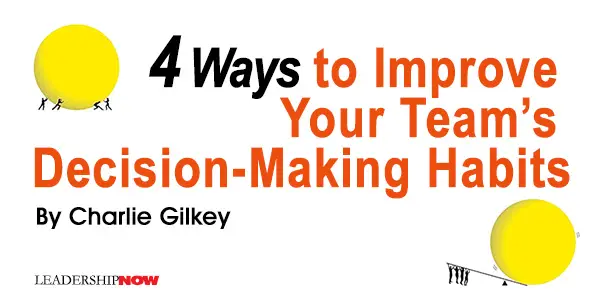 |
 |
12.18.23

4 Ways to Improve Your Team’s Decision-Making Habits
MOST WORK TEAMS have the same silent member who’s constantly dropping the ball. A slacker named “somebody.” Somebody was supposed to call the vendor. Somebody was supposed to check on the competition. Somebody was supposed to consult the boss. But somebody never does anything. Sound familiar? Of course, it does. That’s because you almost certainly have a “somebody” on your team. In my experience, though, as a guy who coaches and trains work teams professionally, I know this to be true: There is no somebody. That is, your team doesn’t have a “somebody” problem; it has a decision-making problem. And that makes knowing who’s responsible for doing exactly what, and by when, a real problem—one that reverberates through everything else your team does. A decision on such-and-such was made at the last team meeting, right? And who in the team would act on it, right? And in what time frame, right? Or does it just seem like you had decided? My money is on the latter. There is hope and help, however. Here are four surprisingly simple ways to improve your team’s decision-making habits. 1. Recognize that decision-making isn’t just social—it’s emotional. In teams, decision-making is about far more than gathering round to go over options and get to a pick. It’s also an emotional undertaking that involves the values, fears, and aspirations of the people making the decisions. Recognizing that emotional component can help your team appreciate why some decisions may be harder to make and act on than others. It also cultivates a decision-making environment where everyone in the team feels heard and respected and where people’s individual insights or skill sets are considered to make the best possible decisions. 2. Remove decision-making bottlenecks with the “three levels” framework. There are three levels of decision-making in a team, and understanding and applying those levels can help teams discern who has the power to make what types of decisions. Level 1 represents decisions that team members can make independently. Level 2 represents decisions that team members can make independently but need to let the rest of the team know when they do. Level 3 represents decisions that team members can make only after getting a thumbs-up from the rest of the team or management (or both). Ideally, about 80 percent of your team’s decisions should fall within Level 1. That not only empowers team members to act within their role or scope, but also escapes endless (and endlessly counterproductive) decision loops. It’s also a great way to prepare people for leadership. When team members get hung up on which level a particular decision falls into, they should schedule a quick conversation with the team to cover any questions or concerns. 3. Use intent-based decision-making. Intent-based decision-making is a powerful tool, as it allows team members to make individual decisions based on a clear-cut, agreed-upon understanding of the team’s overall objectives. So rather than letting people in your team waste precious time while waiting for permission on every little thing, they can proceed independently in the moment, as long as they’re acting within the boundaries of the team’s goals and mission. 4. Keep a team decision log. (Nobody’s memory is that good.) We’re all human beings, so it’s understandable when teams forget who’s responsible for what task or project, especially when, earlier, myriad decisions were made in a rush-rush call or meeting. Maintaining a decision log solves that problem by tracking who in your team is responsible for doing what and by when. It also makes for an easy-breezy accountability tool. In closing, remember that your team doesn’t have a “somebody” problem—it has a decision-making problem. And you can solve it in four surprisingly simple ways.  
Posted by Michael McKinney at 04:39 PM
|
BUILD YOUR KNOWLEDGE
 

How to Do Your Start-Up Right STRAIGHT TALK FOR START-UPS 
Grow Your Leadership Skills NEW AND UPCOMING LEADERSHIP BOOKS 
Leadership Minute BITE-SIZE CONCEPTS YOU CAN CHEW ON 
Classic Leadership Books BOOKS TO READ BEFORE YOU LEAD |